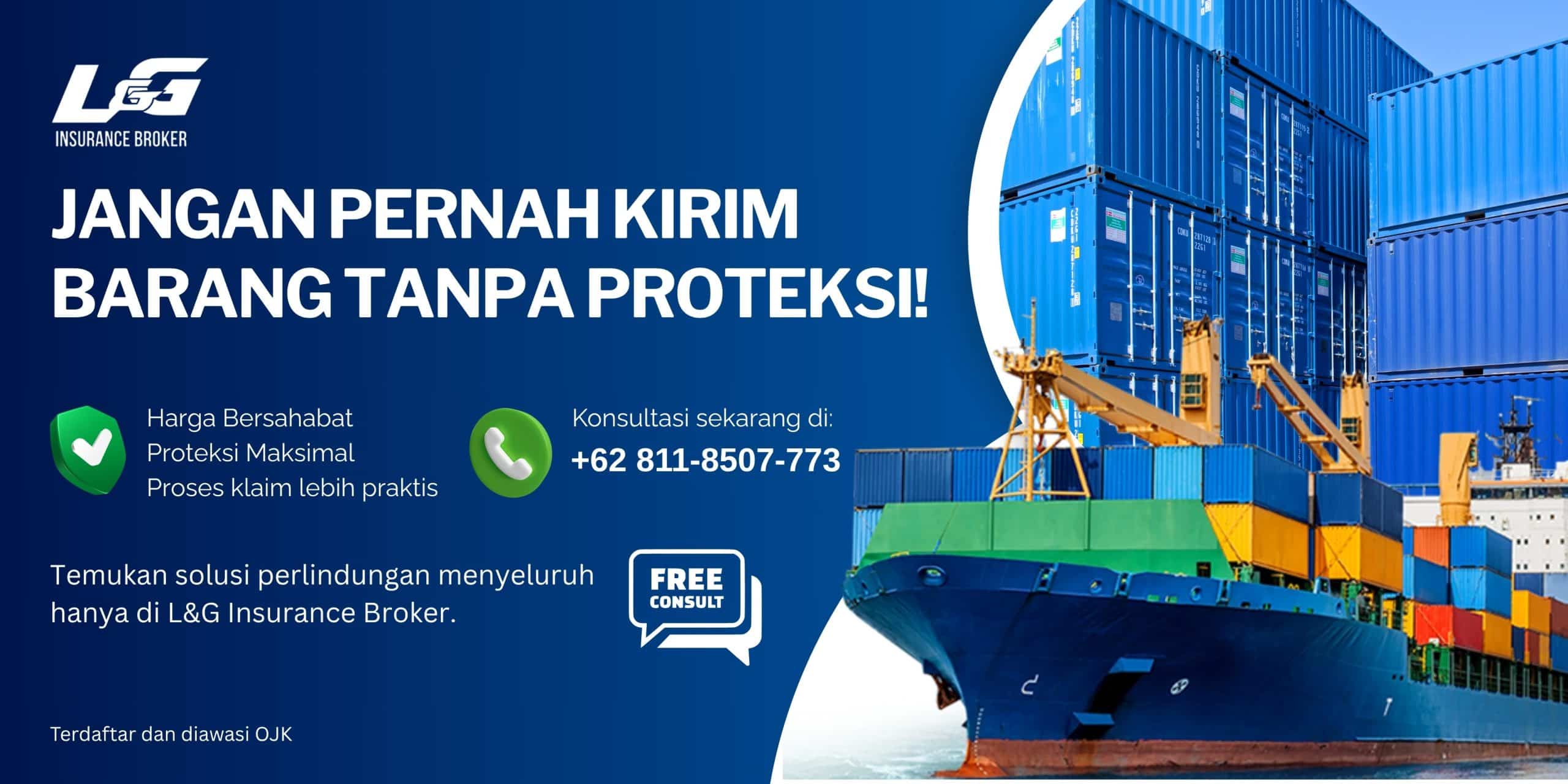Liga Asuransi – Marine cargo insurance began to develop in London in 1600 when the export-import activities began with the colonies. It began with the establishment of cooperation between traders and ship owners at Edward Lloyd’s coffee shop in London. This cooperation was formed because of frequent ship accidents that cause loss of goods at sea and the value of the loss is high.
The concept of marine cargo insurance which started at a coffee shop did not change much in the format, changes were made if there were additions and adjustments according to the requirements.
Along with the development of the times and the increase in the delivery of goods both domestically and export-import, marine cargo insurance is needed to protect goods from losses due to unexpected things.
When the goods have left the warehouse, from then on you have no control over the safety of the goods. However, during the trip there are many risks that can occur. Damaged when he gets on a truck, falls due to road accidents, detaches when he gets on a ship, natural disasters, theft, sinking ships, burning, ship collisions, and others.
To ensure the protection of goods to their destination safely, you really need insurance coverage for the transportation of goods during the shipping process.
Of the many requirements of the marine cargo insurance policy, we would like to discuss one of the requirements regarding “Both to Blame collision”.
Both to blame collision is when a ship collides with another ship due to the negligence of both causing damage to the goods or to the ship itself. If an accident occurs on a ship such as a ship collision, there may be two types of losses that arise, namely Total Loss and Partial Loss.
In the following, we will tell you about total loss and partial loss to help you better understand the calculation of losses caused by ship accidents.
If this article was of interest to you, please share this article with your friends so they can understand it as much as you do.
TOTAL LOSS
A loss or damage can be said to be Total Loss if the item is completely destroyed, has no form at all, is completely destroyed, and its usefulness is completely lost. The definition of Total Loss is divided into two, namely:
- Actual Total Loss
If the loss or damage suffered by the goods is completely destroyed, not in any form, completely destroyed, which means that the loss is 100% caused by the guaranteed perils.
- Constructive Total Loss
If the cost of repairing or restoring the goods exceeds the price of the goods in the market, where the goods are located, then constructively the loss is said to be Total Loss. The market price of goods means the value of goods + freight + tax etc. It can also be said to be constructive Total Loss in terms of loss or damage to goods suffered plus salvage charges is greater than 100% of the value of the goods in the market where the goods are located.
PARTIAL LOSS
Partial Loss is a partial loss or damage that is less than the value of the item. This partial loss claim is divided into two groups, namely:
- Particular Average (partial special loss)
Particular Average is a partial loss or damage to goods caused by a hazard guaranteed in the policy (accidental caused), namely losses suffered by certain people only specifically, does not involve all parties who exist or are involved in the transportation.
The parties involved in a transportation are the Owner of the vessel and the Freight forwarder. Cargo Owner So the loss is grouped in the Particular Average if the loss or damage only involves the ship owner or the goods owner or those who have an interest in freight.
Particular Average is divided into 2 types, namely shortage and damage:
- Shortage in this case, the settlement is based on the Sum Insured for the goods that are not delivered.
- Damage (Damage) The settlement of losses is carried out in two ways, namely by replacing the value of the loss on the damaged goods. Repair damaged items and return them to their original position.
Expenses made by the insured to reduce the possibility of a greater loss (particular charges) are sometimes included as part of the particular average.
Particular charges that can be considered as part of the Particular Average are only expenses that are reasonably incurred by the insured or his representative, and do not include expenses paid to other parties who provide assistance on a contract basis. For example, a ship runs aground, to release the ship from its aground, then there is another party towing the ship, this fee is not considered a Particular Average but a General Average.
- General Average
is a loss that is jointly borne by the parties involved or having an interest in the transportation when the incident occurs. So the losses that occur are shared between the ship owner, freight and the owner of the cargo or goods being transported.
General Average is divided into two types, namely, sacrifice (sacrifice) and costs incurred (expenditure).
- Sacrifice
If part of a ship or part of cargo or goods is intentionally damaged or sacrificed for other salvage purposes. Example: Dispose of goods/cargo at sea (jettison).
Damaged goods exposed to water when extinguishing a fire that occurred on board the ship intentionally damaged the ship’s part in order to save engine damage in the reflosting because the ship ran aground and so on.
- Expenses incurred (Expenditure) a number of costs incurred for rescue purposes. Examples of costs for loading or unloading goods because the ship ran aground, the cost of renting a warehouse to store goods while repairing a damaged ship, the cost of towing a ship that is loading goods and is in a state of danger and so on.
However, not all sacrifices (sacrifice) and expenses (Expenditure) made for the sake of salvage can be charged to other interests on board, which can be charged and become other interests only losses incurred as a result of actions in the General Average.
The types of losses that can be classified into General Average are regulated in Article 699 of the KUHD. The requirements for a loss are said to be a General Average, namely:
- There must be a danger and the danger threatens the safety of all parties
- There must be a deliberate
- sacrifice The sacrifice is made for the benefit of all parties
- The sacrifices made must be reasonable and can be justified.
- Rescue efforts carried out by means of such sacrifices or expenses must be successful.
- The losses that occur must be as a direct result of the actions of the General Average.
Contribution of the General Average
. Basically all interests that survive the actions of the General Average are required to pay a contribution for the losses that occur in the General Average including, the owner of the ship, the owner of the goods or cargo that is on board the ship at the time. incident.
Meanwhile, interests that do not pay the contribution include postal goods transported by the ship concerned, personal belongings of the crew, personal property of passengers loaded without a Bill of Lading.
For example, in this case, Ship A ran aground as a result, the ship suffered damage to the hull, and some of the goods in the hold were submerged in water.
To save the ship and its cargo, part of the cargo is dumped into the sea (Jettison). Therefore: Damage to the hull, Particular Average Loss of wet cargo, Particular Average Loss of cargo dumped at sea (Jettison General Average as long as it can be recognized (a reasonable and justifiable loss), while losses that exceed are still included in the Particular Average.
For Insurance Freight Forwarding Always Use the Services of an Insurance Broker
From the previous information, it is clear that the risk of shipping goods is very high and protecting goods by insuring them is “mandatory” if you do not want to lose because your product is lost and damaged along the way.
Getting the best insurance coverage is not easy. Required extensive knowledge, experience and relationships in the insurance world.
It is best to always use the services of an insurance brokerage company. Insurance brokers are insurance experts who are on your side. They design insurance coverage, negotiate with several insurance companies and assist you in the event of a claim .
One of insurance brokeragethe leading and experienced
For all your insurance needs, contact L&G Insurance Broker now!
Source:
https://lngrisk.co.id/glosari/collission-liability-responsibility-due-coincidence/
—
Looking for Insurance Products? Don’t Waste Your Time and Contact Us Right Now
L&G HOTLINE 24 HOURS: 0811-8507-773 (Call – Whatsapp – SMS)
website: lngrisk.co.id
E-mail: customer.support@lngrisk.co.id
—




















